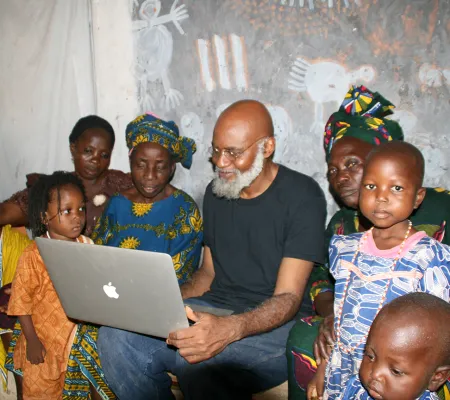This past summer, Professor of Art History Moyo Okediji returned to his hometown in Ile-Ife, Nigeria in the southwestern state of Osun to ostensibly revisit familiar sites, attend a local festival, and give the keynote speech at Obafemi Awolowo University. Instead, he embarked upon a development project in Ile-Ife that refracted international development through the study of art history and art-making.
Okediji saw a city that underutilized its many assets, both the land itself and its people. As a scholar of art history, Okediji believed in the inherent value of art as an object, as a history, and as a vessel for appreciation of local cultural heritage and indigenous knowledge. He set out to make “non-commodity art” or art that is embodied. “I want to impart a sense of belonging, a sense of place, where the city and its shrines can be valued from generation to generation,” said Okediji.
For the purposes of this development initiative, Okediji imagined Ile-Ife as a GownTown (i.e., a meeting point and synergy between two sides of the city, the university and the town). As a GownTown, the development could capitalize on traditional Yoruba governance structure to refocus community resources towards pooling knowledge and recognizing neglected sites of cultural heritage. Specifically, Okediji concentrated on the underutilization of shrines and temples in the city, which would otherwise be rich sources of cultural knowledge and connected to the long political and spiritual history of the city. By pooling resources into a re-appreciation of these existing sources of indigenous knowledge, the GownTown could function as something of a self-sustaining university, investing itself into the community as the community contributes to its growing significance.
Once the concept of embodied art as a means to greater community investment and social development took hold, Okediji believes the concept could then empower Ile-Ife citizens to implement the same sustainable systems in other parts of the community—whether agriculture, commerce, or government. “Perhaps, in his passion to return Nigeria’s university system to a sustainable environment the way he left them years ago, Okediji’s University of African Art (UAA) could serve as a forerunner,” writes Anote Ajeluorou and Tajudeen Sowole in The Guardian article detailing Okediji’s path from a key figure in Onaism to his present development initiatives in Ile-Ife. Still in its infancy, Okediji has thoughtful plans for UAA, including additional artisan workshops and building a leadership structure.
To read more about the initiative, read the full article at The Guardian.


